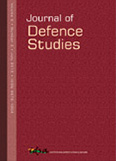Indo – African Defence Cooperation:Need For Enhanced Thrust
The African Continent, rich in minerals and other natural resources, has been figuring prominently in the world affairs in the post Cold War era, for a variety of reasons. The positive aspects in its recent history relate to its success in getting rid of the colonial yoke as also the vestiges of racialism targeted at its people.
- Arvind Dutta |
- Winter 2008 |
- Journal of Defence Studies





